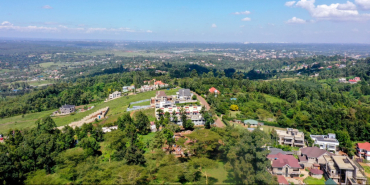County Land Policies Reshape Buyer Trends Across Nairobi’s Suburban Market

Kenya's real estate market is experiencing a significant realignment as suburban areas witness shifting demand patterns, spurred by a combination of unpredictable policy decisions, escalating land prices, and strategic infrastructure investments.
Once-favoured residential locales are now facing declining interest, while previously less desirable peripheries are gaining traction. The fluctuations are fuelled by the erratic nature of county-level policies and infrastructural development, creating an environment where investors grapple with uncertainty. Developers and homeowners alike are navigating this complex landscape, placing increased pressure on county governments to implement sustainable growth strategies that foster long-term confidence and stability.
Over the past decade, areas such as Kitengela in Kajiado County, previously thriving residential hubs, have suffered reputational setbacks due to inconsistent policy pronouncements and soaring land values. Property market analyst Peterson Mwangi, Director of Property Depot, highlights that Kajiado, Kiambu Road, and Thika Road have seen the most dramatic shifts in buyer interest. Suburbs like Rongai and Ngong, once consistently popular, are now less attractive due to high pricing and ambiguous regulatory frameworks, prompting developers to redirect capital toward emerging locales.
Mwangi emphasises the deterrent effect of policy uncertainty, saying, "Policy uncertainty can lead to paralysis. Investors do not like unpredictability. When confidence dips, so does investment."
This sentiment reflects a growing concern within the real estate sector, where investor confidence is crucial for sustained growth and development.
In Kiambu County, regions such as Ruiru's Matangi neighbourhood, have experienced explosive price increases, effectively pricing out a segment of potential homeowners and driving demand towards more affordable options. This dynamic illustrates a fundamental economic principle: as costs rise, demand decreases, a trend increasingly observed across Kenyan property markets.
Conversely, areas such as Kamakis along the Eastern Bypass and Kikuyu in Kiambu County have emerged as attractive locations, buoyed by improved transport infrastructure and competitive property rates. The upgrading of the Eastern and Southern Bypass roads has significantly enhanced connectivity, making these areas viable options for Nairobi's working population. Kikuyu, for example, benefits from its proximity to major roads, a more temperate climate, and access to essential social amenities, creating an appealing package for both residential buyers and investors.
This balanced combination of factors has positioned Kikuyu as a desirable alternative to more established suburbs. While affordability is a primary driver in some areas, prestige remains a key consideration in others. The Kiambu Road corridor, despite its elevated prices, continues to attract sustained demand. Mwangi notes that this area appeals to the upper-middle class, for whom lifestyle conveniences, including elite schools, hospitals, and shopping malls, outweigh cost considerations. The corridor has established itself as a prime location for high-end living beyond Nairobi's traditional affluent suburbs, maintaining momentum even as other areas experience market pressures.
National housing data supports these shifting dynamics. The January 2025 Housing Survey, conducted by the Kenya National Bureau of Statistics (KNBS), reveals that Nairobi remains the primary aspiration for homeownership, attracting 17 percent of prospective buyers. However, due to increasing affordability constraints, Kiambu has risen to become the second most preferred county at 8.6 percent. Nakuru, Machakos, and Mombasa round out the top five. Kajiado, despite its proximity to Nairobi, lags behind at 4.0 percent.
The cyclical nature of suburban appeal raises questions about the potential for once-glamorous neighbourhoods to regain their former status. Mwangi is cautiously optimistic, suggesting that dips in demand often lead to pricing corrections, which can subsequently reignite buyer interest. These dormant phases can also coincide with new amenities or infrastructure investments that revitalise struggling areas. Thus, suburban demand operates in long-term cycles, influenced by both macroeconomic factors and local developments.
Experts caution against relying solely on reactive market dynamics. A concerning trend in Kenya's urban growth is the tendency for infrastructure to follow population settlement, rather than preceding it. Settlements often expand in response to affordability and transport access, prompting public authorities to retroactively provide essential services such as roads, water systems, and utilities.
This reactive approach has resulted in what is commonly described as ad hoc urbanisation: a chaotic, inefficient, and ultimately unsustainable model of development.
This not only burdens local governments but also undermines investor confidence, particularly in areas where unregulated sprawl diminishes property values and overall liveability. Professional planners play a crucial role in navigating these challenges. Mairura Omwenga, Chairperson of the Town and County Planners Association of Kenya (TCPAK), advocates for a comprehensive reimagining of how counties manage land use. Omwenga stresses the importance of physical planners in ensuring coherent development, explaining that "urban planning is not merely about allocating land for housing or commercial use. It's about orchestrating a harmonious ecosystem ,balancing residential, commercial, industrial, recreational, and green spaces in a manner that supports long-term prosperity."
Omwenga argues that Kenya's current approach relies too heavily on informal, developer-led expansion, with insufficient consideration for ecological impacts, infrastructure readiness, or demographic pressures. This lack of foresight has led to what planners term 'reactive urbanism,' where counties respond to existing settlement patterns rather than proactively guiding them. The solution, according to Omwenga, lies in elevating the status and influence of land use planners within county governance. Just as infrastructure projects like bypasses can catalyse demand shifts, deliberate planning policies can shape equitable and economically viable cities.








Add new comment